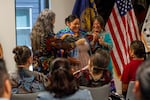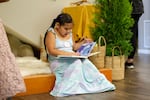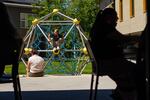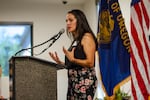
Oscar Arana, Chichimeca, interim CEO of Native American Youth and Family Center, welcomes dozens of community members, elected officials and staff to the opening celebration of NAYA's latest housing endeavor on June 25, 2024. The family housing shelter in Milwaukie will provide support to Native families experiencing homelessness. The shelter is called khwat yaka haws, which translates to "Auntie's Place" in Chinook.
Jarrette Werk / Underscore Native News / Report for America
This story originally appeared on Underscore.news.
khwat yaka haws, meaning Auntie’s Place in the Chinook language, provides culturally-centered services like first foods cooking classes, beading and drumming lessons, and more. The shelter is also intentionally staffed with people who understand the lived experiences of those who need housing to help create a safe and supportive home for Native families experiencing homelessness.
khwat yaka haws is the Native American Youth and Family Center’s latest housing endeavor — a family housing shelter in Milwaukie that will provide support to Native families experiencing homelessness through direct placement to long-term housing, as well as substance use counseling, peer support and mental health support.

Valeria Atenacio, citizen of the Confederated Tribes of Grand Ronde, an adjunct professor at Portland State University, was gifted a scarf as a way to say thank you for giving Auntie’s Place its Chinook name: khwat yaka haws.
Jarrette Werk / Underscore Native News/ Reporter for America
During the opening celebration of khwat yaka haws on June 25, the kitchen got its first big use with catering from local Indigenous pop-up restaurant Javelina.
“As a young girl growing up, I always learned so much at my auntie’s house — at any one of my aunties’ houses in our community,” said Valeria Atenacio, citizen of the Confederated Tribes of Grand Ronde, an adjunct professor at Portland State University who gave Auntie’s Place its Chinook name. “I was welcomed with open arms, was brought in and usually fed, sometimes clothed, taken care of. This is really standing as that pillar in this community.”
Following a celebration that included a blessing of the space by two elders on June 25, families will begin to move in on July 1. After July 1, khwat yaka haus will be open 24 hours a day, seven days a week with a shelter advocate always on site. Each morning, staff will start the day off in a good way with prayer and a smudge that residents will be welcome to participate in.
‘A model for other shelters’

khwat yaka haws houses eight units that can accommodate between five and seven people. Each unit is equipped with essentials like dinnerware, multiple beds, a private bathroom, kitchenette and lockable door to ensure families have access to privacy. One unit that is physically accessible for people with disabilities and has its own washer and dryer is located on the first floor.
Aislin Tweedy / Underscore Native News
The vision for khwat yaka haws began about three years ago when Trell Anderson, the executive director of Northwest Housing Alternatives approached Oscar Arana, now the interim CEO of NAYA, about the possibility of NAYA partnering and running a shelter for Native families on site. Now NAYA leases the shelter building from Northwest Housing Alternatives.
The shelter sits on a larger campus owned by Northwest Housing Alternatives that provides affordable housing to families in Clackamas County. khwat yaka haws is unique in that it is a culturally-specific model with preference given to Native families.
“There’s not a lot of culturally-specific shelters out there,” said Arana, Chichimeca. “We really hope that this is going to become like a model for other shelters, whether it’s other urban Native shelters or for other communities of color.”

A young girl reads a book from the reading nook underneath the stairs of khwat yaka haws on June 25, 2024.
Jarrette Werk / Underscore Native News / Report for America
khwat yaka haws features eight units that can each accommodate five to seven people. The units each contain a bathroom, a kitchenette and a lockable door for privacy. There is one ADA unit with a washer and dryer on the ground floor.
The common spaces throughout the building are covered in murals by local Indigenous artists and feature a community kitchen, laundry facilities and areas for children to both study and play. Downstairs, a medicine station holds wooden bowls filled with sweetgrass, sage and other traditional medicines.
The shelter will serve Native families with at least one member who is under the age of 18. Referrals to the shelter are made through NAYA or the Clackamas Coordinated Housing Access Line.

A child plays on playground equipment in the courtyard of khwat yaka haws after the opening event on June 25, 2024.
Jarrette Werk / Underscore Native News / Report for America
“For this to have come into existence for our Indigenous families is beautiful,” said Andulia Sanchez, Ute and Carrizo, family shelter manager at khwat yaka haws. “We’ve always struggled with generational trauma. Now, we want to focus on generational healing. We are no longer surviving, we are now thriving.”
Sanchez continued by saying she is most excited about the families that will benefit from this new, culturally rich housing complex.
“It means belonging,” Sanchez said. “It means safety. It means love and acceptance.”
Related: Native American organizations call on Oregon Legislature to advance Indigenous community priorities
Homelessness: ‘a product of colonialism’
For Molly Washington, Apache and Mexican, chair of the NAYA Board of Directors, NAYA’s work helps to eliminate or navigate the barriers and systems put in place that harm Native community members.
“It’s harder for Native people, and I know this because I’ve seen it, because I’ve experienced it myself,” said Washington. “It’s harder for us because the systems were designed against us. They were designed not to include us. They’re also designed to oppress, and really to eliminate us. And those are the barriers we face in every single aspect of everything we do.”

Molly Washington, Apache and Mexican, chair of the NAYA Board of Directors, explains some of the systemic challenges Indigenous people face when it comes to homelessness.
Jarrette Werk / Underscore Native News / Report for America
In Clackamas County, in the city of Milwaukie where khwat yaka haus is based, 4% of people experiencing homelessness identified as Native American despite Native people only representing 1.1% of the total population in the county, according to Clackamas County data from June 2022.
“Homelessness in the United States is partly a product of colonialism, genocide and slavery,” said Vahid Brown, deputy director of Housing and Community Development Division at Clackamas County. “And so housing insecurity is not equitably distributed amongst our communities. Amongst people of color, Indigenous folks and Black folks are especially impacted by those histories of exclusion, of dispossession, of colonialism. So we need to invest in those communities directly.”
Related: Pacific Northwest organizations work to support queer Indigenous youth
Clackamas County has invested $1.9 million into khwat yaka haus this year, and is likely to invest more in following years, according to Brown, who called it an “ongoing commitment.”
This family shelter is also part of NAYA’s broader commitment to housing the urban Native community across the Portland metro area. This property marks the seventh that NAYA currently runs, with an eighth under construction. The others so far have all been affordable housing units.

Mixed media artist Arusha Dittmer, Ho-Chunk Nation, helped paint the murals on the walls of khwat yaka haws. She held her daughter as she told the crowd how thankful she was that this shelter will help keep families together. "It's really important that there's a safe space for families to come to and where they're not going to be broken up," Dittmer said. "Fathers and uncles get to stay with the families to prevent the breakdown of that family."
Jarrette Werk / Underscore Native News / Report for America
Arana hopes that this new model, an extension of other affordable housing work, becomes part of a continuum of housing services — from a family shelter to affordable housing and rental assistance and eventually home ownership support to one day fully eliminate Native homelessness.
A braid of dark green sweetgrass is painted along the trim of the upstairs khwat yaka haws hallway. On the opposite wall is a mural painted by Leo White Horse, Rosebud Sioux Tribe, of five Indigenous people riding on blue, white, orange and red horses with the words “Never Homeless Before 1492″ painted beneath the hooves.
Related: Homeless youth in Oregon rebuild their lives with $1,000 a month support
“Homelessness is a federal policy, it’s a state policy, it’s a city policy issue,” James Lovell, Turtle Mountain Band Chippewa, chief community development officer at Chief Seattle Club. He came down to Portland to gift a blanket as a way to honor the space. “It’s not something that Native people did to ourselves. I’m sad to say that the Native people who first saw homelessness have already passed, but I think the Native people who will see the end to Native homelessness are with us today.”
Underscore is a nonprofit collaborative reporting team in Portland focused on investigative reporting and Indian Country coverage. It is supported by foundations, corporate sponsors and donor contributions. Follow Underscore on Facebook and X.
Dear Reader,
For more than 100 years, OPB has offered reliable news and connection. Through wildfires, elections and economic downturns, OPB has been there to inform and connect our communities. Today, journalism faces new obstacles.
But this work is only possible because of people like you — readers who turn to articles like this and continue to engage with independent journalism in our community. If OPB has been a part of your life, if it has helped you see your community or the world more clearly, please consider making a contribution today.
— The OPB Team
Please select an amount to give. Your contribution ensures that fact-based reporting, cultural connection, and stories that strengthen our community remain freely available to everyone.



